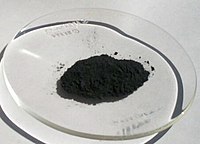
In situ modification provided by a novel wet pyrolysis system to enhance surface properties of biochar for lead immobilization
Sign Up to like & getrecommendations! Published in 2019 at "Colloids and Surfaces A: Physicochemical and Engineering Aspects"
DOI: 10.1016/j.colsurfa.2019.03.012
Abstract: Abstract Surface modification of biochar is significant to obtain more functionalized material for contaminants immobilization. In situ modification, modifying the biochar while the conversion process, was applied by a novel wet pyrolysis system. By using… read more here.
Keywords: wet pyrolysis; system; surface; novel wet ... See more keywords

Uniform Deposition of Li-Metal Anodes Guided by 3D Current Collectors with In Situ Modification of the Lithiophilic Matrix.
Sign Up to like & getrecommendations! Published in 2021 at "ACS applied materials & interfaces"
DOI: 10.1021/acsami.1c13896
Abstract: The lithium (Li)-metal anode is deemed as the "holy gray" of the next-generation Li-metal system because of its high theoretical specific capacity, minimal energy density, and lowest standard electrode potential. Nevertheless, its commercial application has… read more here.
Keywords: metal; lithiophilic matrix; deposition; situ modification ... See more keywords

Controllable CF4 Plasma In Situ Modification Strategy Enables Durable Zinc Metal Anode.
Sign Up to like & getrecommendations! Published in 2023 at "ACS applied materials & interfaces"
DOI: 10.1021/acsami.2c19863
Abstract: Zn metal with high specific capacity and low redox potential is deemed to be an ideal anode material for aqueous zinc-ion batteries (ZIBs). However, the serious dendrite problems induced by the uneven deposition of zinc… read more here.
Keywords: cf4 plasma; situ modification; zinc; anode ... See more keywords

In situ modification of BiVO4 nanosheets on graphene for boosting photocatalytic water oxidation.
Sign Up to like & getrecommendations! Published in 2020 at "Nanoscale"
DOI: 10.1039/d0nr02718a
Abstract: Owing to the sluggish water oxidation process, unearthing an ideal model for disclosing the impact of an architectural approach on the water oxidation activity of photocatalysts becomes a vital issue. Here, we propose an innovative… read more here.
Keywords: situ modification; water oxidation; bivo4 nanosheets; oxidation ... See more keywords

Large-scale synthesis of monodisperse Prussian blue nanoparticles for cancer theranostics via an “in situ modification” strategy
Sign Up to like & getrecommendations! Published in 2019 at "International Journal of Nanomedicine"
DOI: 10.2147/ijn.s183858
Abstract: Background The intrinsic properties of Prussian blue (PB) nanoparticles make them an attractive tool in nanomedicine, including magnetic resonance imaging (MRI), photoacoustic imaging (PAI), and photothermal therapy (PTT) properties. However, there still remains the challenge… read more here.
Keywords: blue nanoparticles; synthesis; cancer; stability ... See more keywords

In-situ Modification of Graphene Oxide by Insoluble Sulfur and Application for Nitrile Butadiene Rubber
Sign Up to like & getrecommendations! Published in 2020 at "International Polymer Processing"
DOI: 10.3139/217.3910
Abstract: Abstract Insoluble sulfur (IS) is prepared at low temperature with graphene oxide (GO) as stabilizer and ammonium persulfate as initiator. The FTIR and Raman patterns show that the non-conjugate double bond of GO can couple… read more here.
Keywords: graphene oxide; application; insoluble sulfur; situ modification ... See more keywords

Novel In Situ Modification for Thermoplastic Starch Preparation based on Arenga pinnata Palm Starch
Sign Up to like & getrecommendations! Published in 2022 at "Polymers"
DOI: 10.3390/polym14224813
Abstract: Thermoplastic starch (TPS) has three main disadvantages, i.e., poor mechanical properties, low thermal stability and water sensibility. To overcome these disadvantages, TPS properties can be improved by starch modification, adding reinforcements and blending with other… read more here.
Keywords: situ modification; tps; thermoplastic starch; starch ... See more keywords